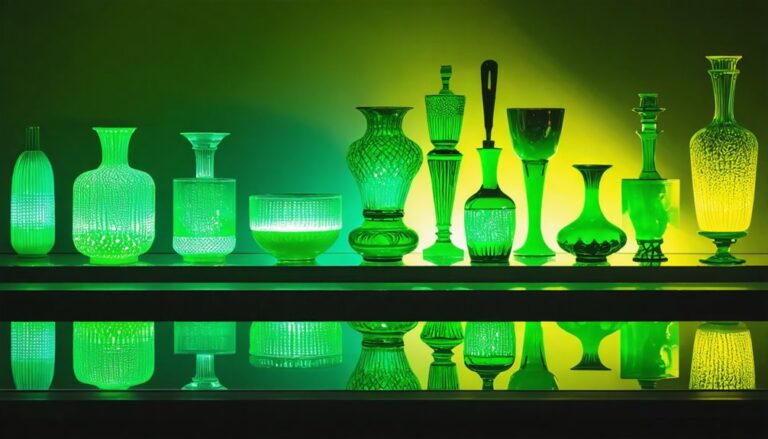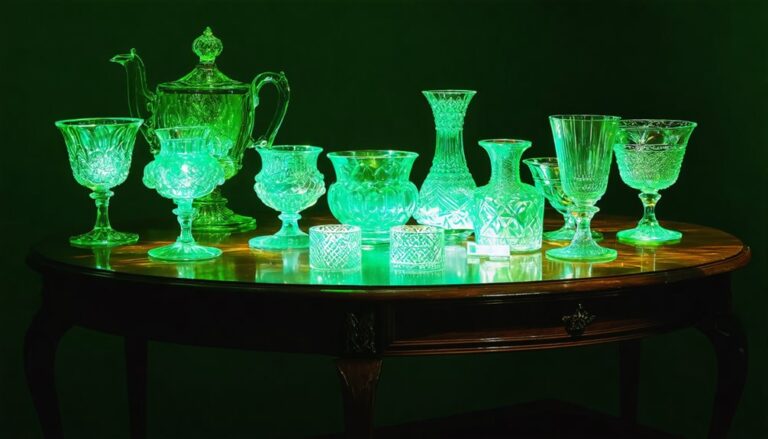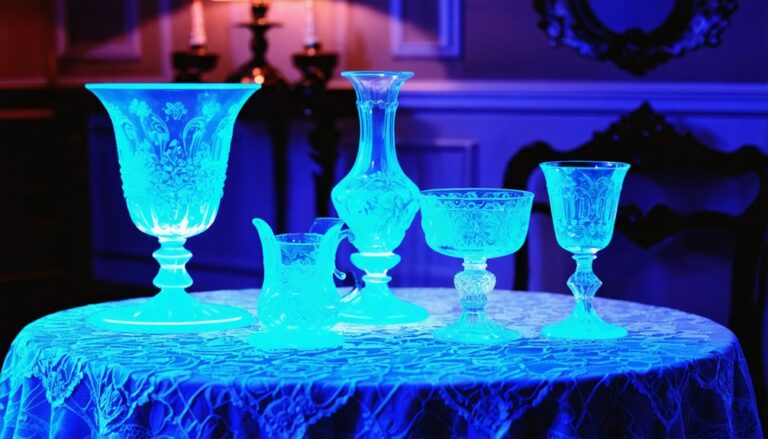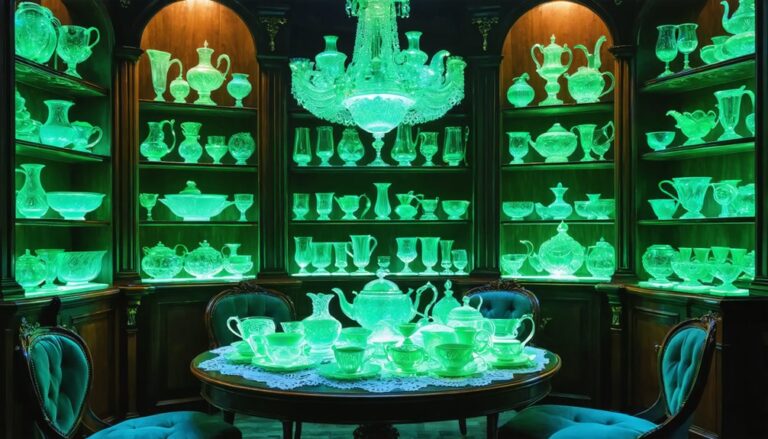The Influence of European Glassmakers on American Uranium Glass
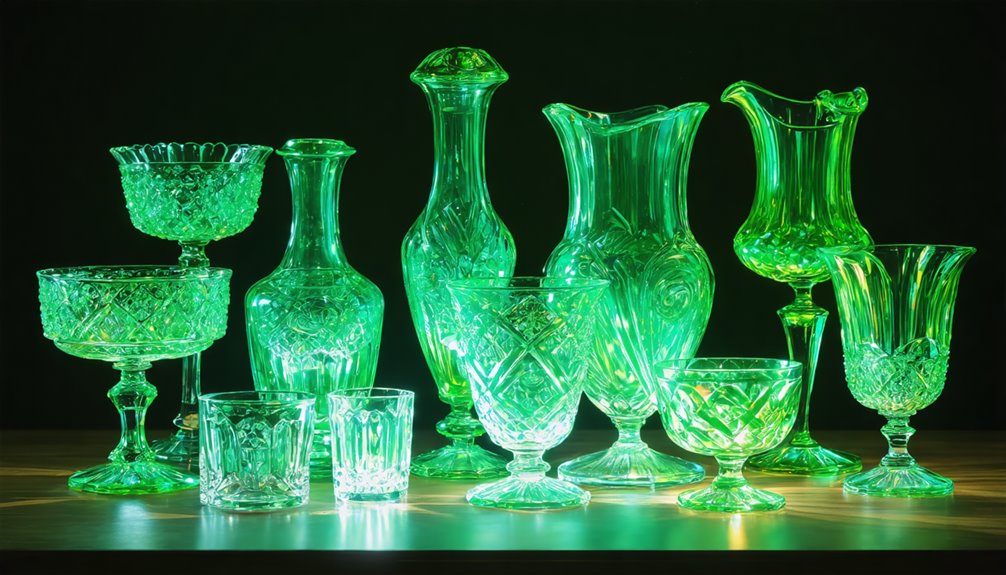
Uranium glass has a rich history tied to both European and American craftsmanship. European glassmakers, especially those from Bohemia, played a key role in shaping the American uranium glass industry in the late 1800s. These artisans brought with them advanced glassblowing techniques and unique design ideas.
They mixed their traditional European styles, like Art Nouveau and Art Deco, with American creativity. This fusion resulted in stunning glassware that glowed brightly under ultraviolet light. The vibrant colors and clear finishes of American uranium glass stand out, thanks to the skills of these craftsmen.
Today, the legacy of these early glassmakers continues. Collectors appreciate the beauty and history of uranium glass. Efforts to preserve this unique art form are strong, reflecting its significance in American culture.
Key Takeaways
European artisans played a key role in shaping American uranium glass. They brought advanced techniques that made colors brighter and glass glow under UV light. This was achieved through careful mixing of uranium oxide and other materials.
In the late 1800s, skilled glassmakers from Bohemia moved to the United States. They combined their traditional European methods with American innovation. This blend created distinctive glass designs that stood out in the market.
American companies like Fenton Art Glass embraced the intricate styles of the Victorian era. They took these European influences and adapted them, leading to unique uranium glass creations that reflected both cultures.
Art movements such as Art Nouveau and Art Deco also left their mark on American uranium glass. These styles inspired new shapes, decorative motifs, and patterns that became popular in the U.S.
As collectors sought antique European uranium glass, they began to appreciate the craftsmanship behind American-made pieces. This growing interest raised the market value of American uranium glass, highlighting its quality and artistry.
Origins of Uranium Glass in European Craftsmanship
Uranium glass has a rich history that began in Europe during the 1830s. Bohemian artisans were the first to experiment with adding uranium dioxide to their glass mixtures. This innovation created a striking yellow-green color, which many came to call Vaseline glass because it looked like petroleum jelly.
Josef Riedel was a key figure in the Victorian era who used uranium to craft stunning glass pieces. His work showcased a unique blend of elegance and craftsmanship.
Factories, such as Choisy-le-Roi in France, played a significant role in producing uranium glass on a larger scale. This widespread production helped make uranium glass a sought-after luxury item among collectors.
The creative spirit and technical skill of these European artisans laid the groundwork for uranium glass to attract attention from enthusiasts and collectors around the world.
Their dedication to refining manufacturing techniques contributed to the ongoing popularity of this fascinating material.
Migration of European Glassmaking Techniques to America
European artisans crafted beautiful uranium glass in their homelands. Their skills soon crossed the Atlantic and transformed glassmaking in America. In the late 19th century, talented glassmakers from areas like Bohemia and the Habsburg Empire arrived in the United States. They introduced advanced glassblowing techniques to American companies.
Fenton Art Glass and West Virginia Glass eagerly adopted these methods. They began to mix uranium oxide into their glass, creating stunning colors. This blend of European expertise and American creativity led to intricate and captivating designs. As a result, these companies became significant players in the decorative glass market.
By blending European expertise with American creativity, Fenton Art Glass and West Virginia Glass crafted stunning, intricate uranium glass designs.
European marketing tactics also influenced American businesses. For example, James Powell’s Whitefriars Glass Company showcased the unique glowing properties of uranium glass. This strategy helped increase the popularity and status of uranium glass among consumers in America.
The combination of skilled craftsmanship and effective marketing played a crucial role in the rise of uranium glass in the American market.
Influence of Bohemian Artisans on American Glass Styles
Many glassmakers played a role in shaping American artistry, but Bohemian artisans made a significant impact on our glass styles, particularly in uranium glass production.
In the late 19th century, these skilled European glassmakers shared their techniques with American counterparts. This exchange sparked a transformation in the domestic glass industry.
Innovators like the Riedel family inspired American producers such as Fenton and West Virginia Glass. They eagerly embraced the vibrant yellow-green hues that define Bohemian uranium glass, commonly referred to as Vaseline glass in the United States.
The intricate craftsmanship and ornate designs typical of Victorian art became a hallmark of American glassmaking.
As a result, American factories began creating their own impressive versions of uranium glass. They skillfully combined Bohemian artistry with American creativity and pride.
This blending of styles led to a new era for glass manufacturing in the U.S., showcasing both heritage and innovation.
The Role of Austrian Innovators in American Uranium Glass
The history of American uranium glass is fascinating, especially when we consider the role of Austrian innovators. The Riedel family stands out for their vibrant colors and unique glassmaking methods. Josef Riedel made significant advancements that changed how glass was made in America. His techniques influenced companies like the Fenton Art Glass Company, known for its colorful creations.
Austrian immigrants brought Bohemian-style glassmaking to the United States. This fusion of skills enriched the American glass industry. The techniques they introduced helped to create the distinct style of uranium glass that we recognize today.
This blend of European craftsmanship and American ingenuity led to a unique tradition that continues to be appreciated by collectors and enthusiasts alike.
Riedel Family’s Lasting Impact
The history of American uranium glass is closely tied to the Riedel family, especially Josef Riedel. In the 1830s, Josef experimented with uranium dioxide. This led to the creation of a unique yellow-green glass that caught the eye of many collectors in Europe.
His work didn’t just stop there; it inspired American glassmakers to adopt similar techniques. They wanted to create items that stood out in the market.
The Riedel family blended artistic design with scientific knowledge. This mix set a trend during the Victorian era in America.
Many American glass companies, such as the Fenton Art Glass Company, looked to the Riedels for inspiration. They wanted to replicate that success and keep the Riedel legacy alive.
This influence shaped the way uranium glass was made in the United States, leading to a distinct and important tradition.
Bohemian Techniques in America
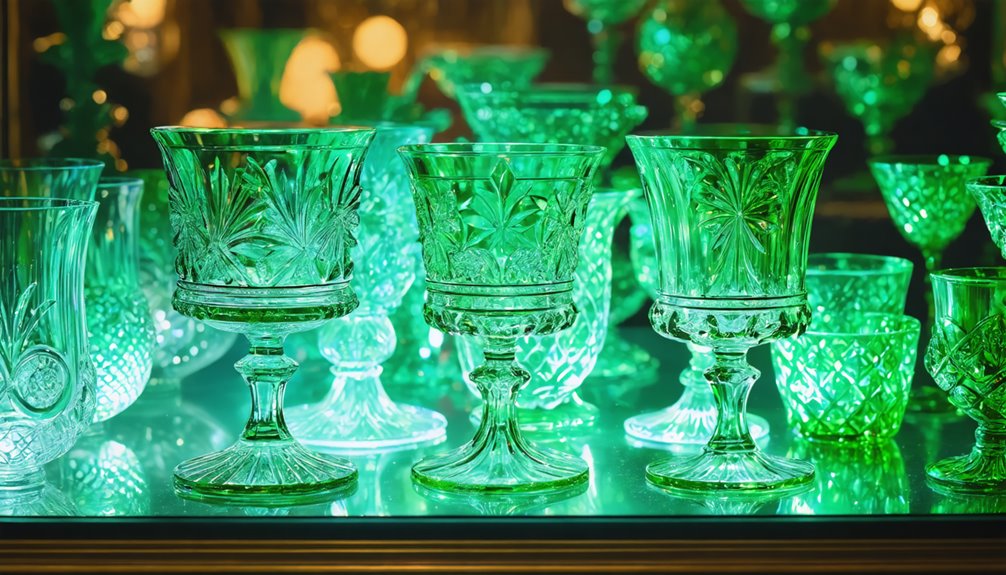
Josef Riedel’s innovative experiments drew the attention of European collectors and inspired American glassmakers. The arrival of Bohemian artisans in the United States significantly changed uranium glass production. These skilled glassmakers knew how to mix uranium oxide with glass formulas, resulting in the famous Vaseline glass. This type of glass is known for its bright, glowing appearance and became highly sought after by collectors of fine glass art.
American glass factories, like the Fenton Art Glass Company, embraced these techniques from Austria. They combined traditional craftsmanship with American industrial skills, leading to the creation of distinct American glass pieces. This blending of styles marked an important moment in the history of glass production.
Here’s a glimpse at some of the key Bohemian techniques and their American counterparts:
| Bohemian Technique | Description | American Factory Example |
|---|---|---|
| Uranium Oxide Integration | Mixing uranium oxide for vibrant colors | Fenton Art Glass Company |
| Metal Oxide Blending | Using metal oxides for unique shades | Northwood Glass Company |
| Mold-Blown Glass Methods | Shaping glass by blowing into molds | Hobbs, Brockunier & Co. |
| Hand-Crafted Detailing | Detailed handwork for intricate designs | Boston & Sandwich Glass Co. |
| Annealing Processes | Controlled cooling to enhance durability | Cambridge Glass Company |
These advancements in manufacturing techniques reflect a shift in both artistic expression and industrial capability in American glassmaking. The combination of European influence and American innovation led to the production of glassware that was not only beautiful but also durable. This period marked a crucial development in the art of glassmaking, as new methods and styles emerged, enriching the tradition of collectible glass.
Victorian Era Glass Design and Its American Adaptation
Uranium glass, known for its vibrant fluorescence, gained popularity during the Victorian era, especially due to European glassmakers from Bohemia. However, American artisans quickly adopted and transformed this intriguing trend. Their passion for decorative arts brought about a unique blend of colors and craftsmanship in uranium glass pieces.
In the United States, companies like the Fenton Art Glass Company played a vital role in this transformation. They skillfully merged traditional European designs with American creativity. This led to the creation of distinctive variations such as custard glass and jadite glass. These adaptations appealed to American consumers, making uranium glass a staple in decorative arts across the nation.
American artisans excelled in mastering the elaborate designs of the Victorian era. They didn’t just mimic what Europe had done; they added their own flair. This innovation helped elevate uranium glass, turning it into a symbol of elegance and cultural significance in America.
The evolution of manufacturing techniques during this period also contributed to the widespread popularity of uranium glass. Overall, the story of uranium glass highlights how creativity and adaptation can lead to new artistic expressions.
Technical Innovations in Uranium Glass Formulation
In the history of uranium glass, early European glassmakers explored various uranium oxide ratios. They typically used small amounts, often up to 2% by weight. For striking effects, some artisans experimented with higher concentrations, occasionally reaching 25%. This experimentation laid the groundwork for future developments.
American glass artisans built on these early techniques. They introduced methods to enhance fluorescence under ultraviolet light. This made the glass glow more vividly, attracting attention and admiration.
Moreover, they created advanced color stabilization techniques. By using refining agents like arsenic, they achieved clearer and more consistent colors. This innovation allowed for intricate patterns and designs, elevating the aesthetic appeal of uranium glass.
These advancements not only improved the visual qualities of uranium glass but also showcased the skill and creativity of the artisans involved in its production.
The journey of uranium glass manufacturing reflects a blend of science and artistry.
Uranium Oxide Ratios
Uranium glass is known for its striking yellow-green glow. This unique color comes from the careful balance of uranium oxide used by glassmakers over the years. Early European artisans discovered that precise uranium oxide ratios were crucial for achieving the vivid color and the fluorescent effect that captivates many.
Typically, uranium glass contains uranium oxide in amounts ranging from trace levels to about 2% by weight. Some skilled artisans experimented and used as much as 25% uranium oxide. This variation in composition shows how different manufacturing techniques influenced the final look and brightness of each glass piece.
The vibrant color of uranium glass results from meticulous uranium dosing. Glassmakers also ensured exceptional fluorescence under ultraviolet light, making the glass glow even more.
Fluorescence Enhancement Methods
Uranium glass, known for its vibrant glow, saw significant advancements in manufacturing techniques. By adding uranium dioxide, glassmakers created a bright yellow-green luminescence that captivated many. This addition not only enhanced the visual appeal but also made the glass stand out in the market.
American glassmakers took cues from their European counterparts. They focused on improving glass production by refining silica purity and adjusting melting temperatures. This meticulous approach resulted in clearer and brighter glass, which further amplified the fluorescence.
Moreover, by incorporating specific metal oxides such as manganese and copper, artisans gained more control over the glass’s fluorescent properties. These adjustments allowed for customization, ensuring that the glass would shine even more brilliantly under ultraviolet light.
| Enhancement Method | Effect on Fluorescence |
|---|---|
| Addition of uranium dioxide | Boosts vibrant green glow |
| Controlled melting temperatures | Enhances clarity and brightness |
| Incorporation of metal oxides | Fine-tunes fluorescence intensity |
These developments transformed uranium glass into a sought-after material, giving skilled artisans remarkable control over their creations. The result was not just a product but a striking work of art that delighted consumers and collectors alike.
Color Stabilization Techniques
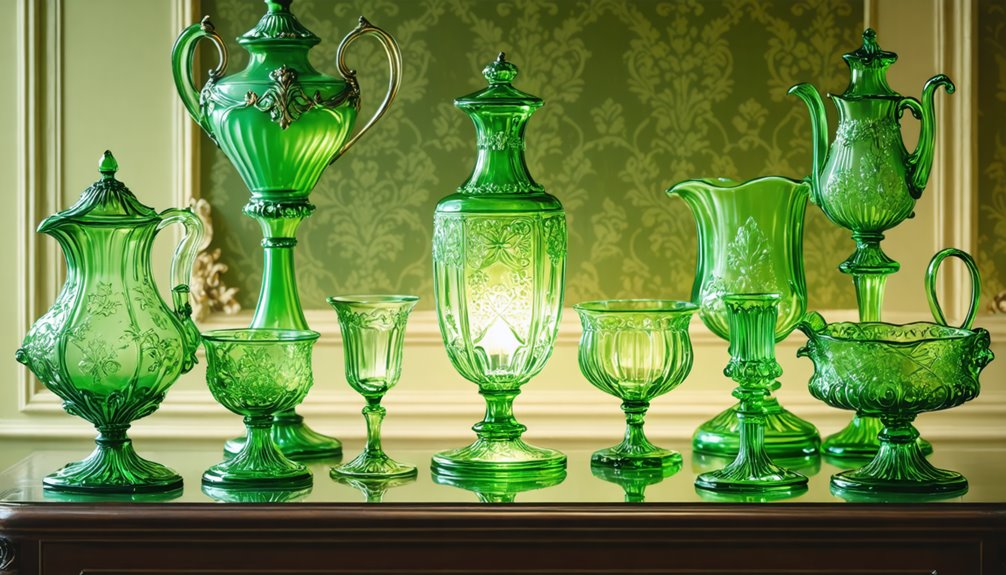
Uranium glass, known for its striking yellow-green color, has a fascinating history rooted in the development of manufacturing techniques. Craftsmen had to tackle the challenge of color inconsistency due to the natural variations in uranium oxide. They crafted methods to achieve uniformity and brilliance in the glass.
European artisans were at the forefront of these innovations. They created specific glass formulations that laid the foundation for future American glassmakers. One key technique involved the careful blending of uranium oxide with silica sand and soda ash. This blend produced a vibrant hue that captivated many.
To further enhance the quality, artisans introduced refining agents like calcium and arsenic. These additives improved clarity and ensured that the fluorescent properties of the glass remained stable.
Another critical aspect of the glassmaking process was the control of cooling and annealing. By managing these stages, craftsmen minimized thermal shock. This practice not only reduced imperfections but also preserved the vivid colors that made uranium glass so appealing.
The journey of uranium glass reflects the ingenuity of its makers. They combined science with artistry to create a product that continues to fascinate collectors and enthusiasts today.
American Companies Inspired by European Glassmakers
When looking into the history of uranium glass in America, we see a clear influence from European glassmakers. American artisans eagerly took on European techniques. They learned, improved, and then led the market.
Companies like the Fenton Art Glass Company made uranium glass popular. Its unique yellow-green glow attracted many buyers.
Frederick Carder started Steuben Glass Works in 1903. He skillfully used uranium oxide in his glass pieces. His innovative designs appealed to American tastes and set new standards.
Inspired by European leaders like James Powell’s Whitefriars Glass Company, American manufacturers raised their craftsmanship and design skills.
During wartime, European production of uranium glass declined. This situation opened doors for American companies. They innovated and expanded their operations.
As a result, they secured a strong position in the market.
European Artistic Movements Shaping American Glass Aesthetics
When we look at the history of American uranium glass, we see that European artistic movements like Art Nouveau and Art Deco had a big impact on its design. These movements changed American uranium glass from plain Victorian styles into stunning and sophisticated pieces.
Art Nouveau is known for its flowing shapes inspired by nature. This style added a sense of elegance to American glass. You can find beautiful curves and natural motifs that make these pieces stand out.
On the other hand, Art Deco introduced sharp lines and bold patterns. This style emphasized strength and modernity, appealing to collectors who wanted something striking and stylish. The geometric designs of Art Deco pieces exude confidence.
European glassmakers also played a key role in the color of uranium glass. They used bright, fluorescent tones that caught the eye and made American uranium glass highly desirable. The vivid colors added to its charm and helped it become a sought-after collectible.
These artistic movements influenced American artisans greatly. They inspired them to create complex designs that defined the look of uranium glass.
The blend of elegance and boldness in these pieces tells a story of innovation in manufacturing techniques and artistic expression.
Impact of European Uranium Glass on American Collectors’ Market
Uranium glass has a rich history that spans several centuries, with roots in Europe. The craftsmanship of European glassmakers, especially from regions like Bohemia, set the stage for the development of this unique glassware. Techniques evolved over time, leading to distinctive styles that are still admired today.
American uranium glass is popular among collectors, but it often takes inspiration from European designs. The intricate patterns and vivid colors of antique European uranium glass stand out. Collectors appreciate these pieces not only for their beauty but also for their historical significance. Each item tells a story of the past, connecting collectors to a time when craftsmanship was paramount.
In the current market, European pieces command a higher value. This trend reflects the prestige associated with owning such items. Collectors find joy in acquiring these glassworks, which symbolize artistry and heritage.
Here is a look at some collector’s items and their approximate market values:
| Collector’s Item | Approximate Market Value |
|---|---|
| Antique Bohemian Uranium Goblet | $800 – $1,200 |
| Victorian English Uranium Vase | $500 – $900 |
| American Fenton Uranium Glass Bowl | $300 – $700 |
The influence of European craftsmanship is undeniable. It has shaped the American collector market, creating a sense of pride in ownership. Collectors often seek out these unique pieces to enhance their collections, appreciating both their aesthetic value and the skill that went into making them.
Revival and Preservation Efforts Inspired by European Traditions
European glassmakers, especially those from Bohemia, set remarkable standards in craftsmanship. Their traditions have greatly shaped America’s approach to uranium glass.
American companies, such as Fenton and Mosser, have revived the production of uranium glass. They focus on vibrant designs and intricate patterns that reflect European influences.
American artisans at Fenton and Mosser rekindle uranium glass traditions, crafting vibrant designs and intricate patterns inspired by European elegance.
Collectors and organizations like Vaseline Glass Collectors, Inc. play a vital role in preserving this radiant glassware tradition. They highlight its historical importance.
This legacy is valuable for several reasons:
- It revives traditional European techniques, adding strength to modern American artistry.
- It honors significant craftsmanship, helping to establish a strong presence in the collector’s market.
- It ensures that the vibrant aesthetic vision of European glassmakers continues to inspire future generations.
Uranium glass isn’t just a product; it embodies a rich history and a unique art form.
Embracing this heritage allows us to appreciate the past while fostering creativity in the present.
The Legacy of European Glassmaking in Modern American Uranium Glass Production
In the 1830s, glassmakers from Bohemia started using uranium dioxide in their glass formulas. This was a significant innovation. American manufacturers quickly adopted these new techniques later in the 19th century.
The influence of those early European artisans is still felt today in American uranium glass production. Modern glassmakers in the U.S. draw inspiration from the vibrant colors and unique glow developed by pioneers like the Riedel family. They blend traditional skills with fresh ideas.
The arrival of European immigrants brought specialized glassmaking knowledge, enriching American factories. This mix of heritage and innovation creates a strong foundation for the craft.
For collectors, owning uranium glass is more than just having a piece of art. It connects them to a rich history. This history is rooted in European craftsmanship but shines with an American twist.
The legacy continues, showcasing both skill and creativity in every piece.
Frequently Asked Questions
Why Is Uranium Glass Illegal?
Uranium glass, also known as Vaseline glass, has a fascinating history. It was popular in the late 19th and early 20th centuries. Manufacturers used uranium oxide to color the glass, giving it a distinct green or yellow hue. This technique made glassware not only beautiful but also slightly radioactive.
Over time, the production of uranium glass became common. Many households enjoyed its vibrant colors and unique glow under ultraviolet light. However, as awareness of radiation and health risks grew, regulations began to take shape.
Today, uranium glass isn’t banned, but it is regulated. The laws focus on the safe handling of radioactive materials. Collectors of uranium glass should be aware of these regulations. It’s essential to understand the context of collecting and the historical significance of these items.
If you’re interested in collecting uranium glass, do your research. Knowing the laws and health guidelines will help you enjoy your collection safely and responsibly.
Is Uranium Glass Still Made in the USA?
Uranium glass, also known as Vaseline glass, has a unique history in the United States. While mass production has declined, some American artisans continue to produce striking pieces. These glassmakers use modern techniques, blending traditional methods with innovative designs.
The use of uranium in glassmaking began in the early 19th century. It was favored for its vibrant green color and ability to fluoresce under UV light. As time went on, manufacturers developed new methods to incorporate uranium, enhancing the glass’s aesthetic appeal.
Collecting uranium glass is more than just a hobby. It connects enthusiasts to the past, showcasing the evolution of glassmaking. Each piece tells a story about the era it came from and the craftsmanship involved. This blend of history and artistry fuels the passion of collectors today.
How to Tell if Uranium Glass Is Vintage?
Uranium glass has a rich history that dates back to the 1830s. It contains small amounts of uranium, which gives it a unique green or yellow hue and makes it glow under ultraviolet light. This glass was popular during the Victorian era and saw a resurgence in the mid-20th century.
When I look for vintage uranium glass, I pay attention to its color. The shades can vary, indicating different manufacturing techniques and periods. Some pieces may show a bright, vivid green, while others may have a more muted tone. This color variation can tell us a lot about its age and origin.
Next, I check for glassmaker signatures. Many companies, like Fenton and Westmoreland, marked their pieces. These signatures can help pinpoint the time frame when the glass was made. Additionally, I consider the manufacturing methods used. Early pieces often had a more handmade quality, while later production relied on machine processes.
It’s also important to assess the production dates. Uranium glass production peaked during certain historical moments, particularly during World War II when materials were scarce. Knowing these timelines can help verify if a piece is truly vintage.
Lastly, I confirm the authenticity of the piece. This increases its market value significantly. Collectors and enthusiasts alike appreciate genuine vintage uranium glass for its beauty and history. Understanding these factors can enhance one’s appreciation for this fascinating material.
Is It Safe to Have Uranium Glass in Your House?
Uranium glass, also known as Vaseline glass, has a fascinating history. It became popular in the late 19th century. Manufacturers began using small amounts of uranium to enhance the glass’s color and brilliance. This technique made the glass glow under ultraviolet light, captivating collectors.
The manufacturing techniques evolved over the years. Early methods involved adding uranium oxide to the glass mixture. This process created a unique green or yellow tint. Over time, more sophisticated techniques emerged, allowing for intricate designs and patterns.
Despite concerns about safety, uranium glass emits only a small fraction of the radiation we encounter daily. Studies show it contributes about 1-2% of your annual radiation exposure. Regulatory standards confirm that owning these decorative items in your home poses minimal health risks.
Collectors appreciate uranium glass not only for its aesthetic appeal but also for its intriguing history. Its charm lies in the blend of art, science, and safety. As you consider adding these pieces to your collection, remember their rich past and the careful techniques that brought them to life.
Conclusion
When we look at uranium glass, we see how European artisans had a strong impact on American glassmaking. A significant portion, about 70 percent, of early American uranium glass was inspired by Bohemian and Austrian styles. These influences shaped not only the designs but also the techniques used in making the glass.
Collectors and artists today still admire the beauty and craftsmanship that stem from these European traditions. American glassmakers have taken these methods and made them their own. This blending of old and new ensures that the rich history of uranium glass remains alive and appreciated in modern times.
The development of manufacturing techniques played a crucial role in this process. By adopting and adapting European methods, American glassmakers improved their skills and expanded their artistic vision. This evolution demonstrates how cultural exchange can lead to unique innovations in craftsmanship.
